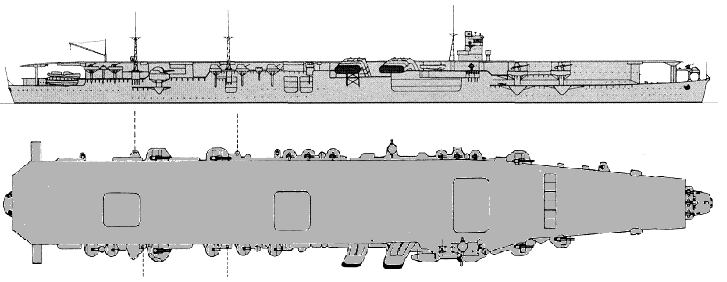

Soryu 1942
| Name | No | Yard No | Builder | Laid down | Launched | Comp | Fate |
| 蒼龍 [Soryu] | Kure K K | 20.11.1934 | 23.12.1935 | 29.12.1937 | sunk 4.6.1942 |
|
Displacement standard, t |
15900 |
|
Displacement full, t |
19800 |
|
Length, m |
210.0 pp 222.0 wl 227.5 oa |
|
Breadth, m |
21.3 wl 26.0 fd |
|
Draught, m |
7.62 |
|
No of shafts |
4 |
|
Machinery |
4 sets Kampon geared steam turbines, 8 Kampon boilers |
|
Power, h. p. |
152000 |
|
Max speed, kts |
34.5 |
|
Fuel, t |
oil 3670 |
| Endurance, nm(kts) | 7750(18) |
|
Armour, mm |
belt: 40, deck over machinery: 25, deck over magazines: 55 |
|
Armament |
6 x 2 - 127/40 89-shiki, 14 x 2 - 25/60 96-shiki, 71 aircraft (A2N, A4N, A5M fighters, D1A diving bombers, B4Y, B5N torpedo bombers) |
|
Complement |
1100 |
Aircraft facilities (fd - 5,639m², ha - 5,647m² / 25,205m³): Flight deck: 216.9x26.0m. Upper hangar: 171.3x18.0x4.6m, lower hangar: 142.4x18.0x4.3m. Lifts: fore (11.5x16.0m), medium (11.5x12.0m) and aft (11.8x10.0m). Aircraft fuel stowage: 1200t.
| year | fighters | diving bombers | torpedo bombers |
| 12.1937 | 18 A4N and A5M | 27 D1A2 | 12 B4Y |
| 12.1941 | 26 A6M2 | 17 D3A1 | 18 B5N2 |
| 6.1942 | 21 A6M2 | 21 D3A1 | 18 B5N2 |
Project history: The occurrence of Soryu and Hiryu was a result of London Naval Conference of 1930, according to its decisions Japan can some strengthen the carrier fleet. (The parity of total tonnage of aircraft-carriers of the USA, Great Britain and Japan now made 10:10:7 instead of provided by the Washington conference 5:5:3). Both ships were built under 1st Supplementary Programme of 1931.
By architecture these ships became prototypes for almost all subsequent Japanese carriers. They had continuous flight deck, two-level hangar, small island superstructure, two deflexed down and aft funnels and three elevators. As a whole ship design (within the limits of displacement assigned on it) has appeared rather successful, harmoniously combining high speed with strong AA armament and impressive number of air group. However, impressive area of hangars claimed small height of hangar levels, because of what on lower level fighters could take places only.
Hull form of Soryu formed on the basis of lines drawing of heavy cruiser, machinery has been unified with cruiser Suzuya. Propulsion qualities of aircraft carrier have appeared rather high: at displacement, almost twice larger, than on Mogami, Soryu made only on 2kts lower speed.
Armouring looked modest enough: it was defined by limited displacement. The thickness of belt abreast machinery was 40mm, armour deck was covered by 25mm steel plates. Local protection of magazines had the greatest thickness: horizontal 55mm, vertical 140mm.
Ship protection: Main 40mm belt protected only machinery, main 25mm (12.7mm armor on 12.7mm plating) deck connected with its upper edge. Magazines had 140mm vertical and 55mm horizontal protection. There was 45mm longitudinal anti-torpedo bulkhead.
Modernizations: None.
Naval service: Both ships were lost in battle at Midway. Soryu in the morning 4.6.1942 was damaged by American carrier aircraft. Ship received three 454kg-bomb hits, fires have begun. Later 30 minutes crew begun to abandon the ship ÀÂ, and in 8 hours she has blown up and sunk. Hiryu in the afternoon 4.6.1942 was damaged by American carrier aircraft. She received four 454kg-bomb hits and four near misses. Fires were begun, in 4 hours engine rooms were foundered then crew abandoned the ship. In the morning 5.6.1942 Hiryu has been sunk by torpedoes of own destroyers.

Soryu 1938
© Ivan Gogin, 2008-14